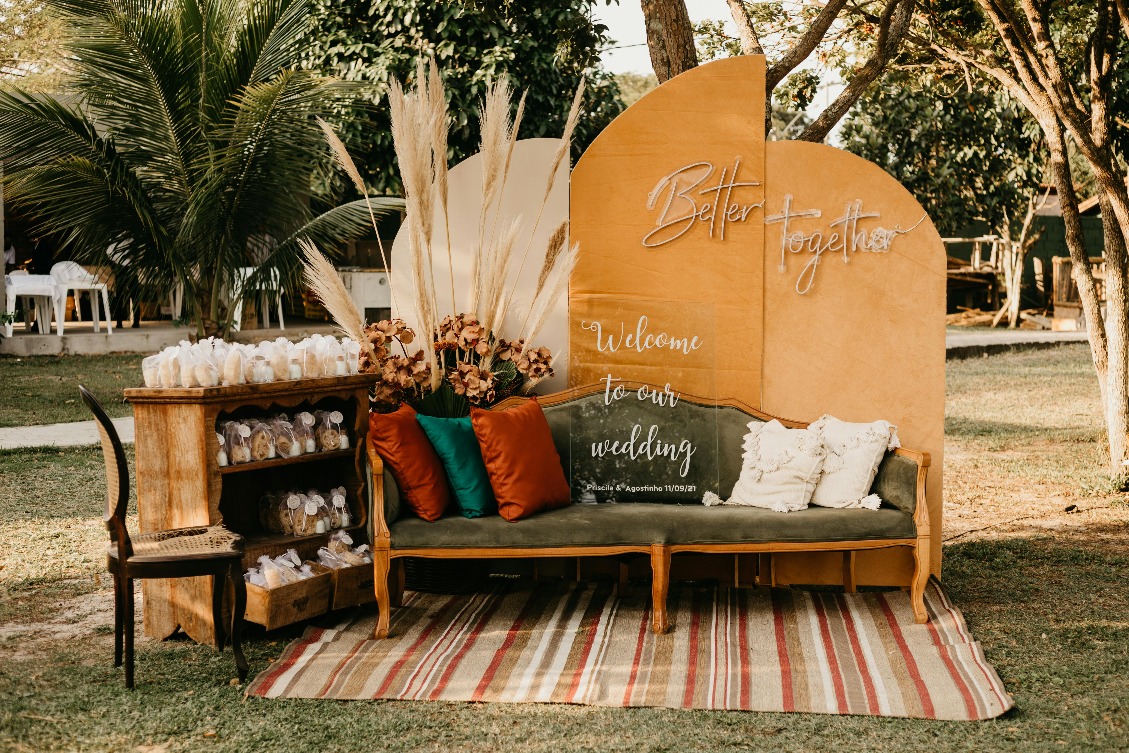- welcome signs
- directional signage
- reserved seating signs
- ceremony programs
welcome signs
Your welcome sign is another piece of stationery that does exactly what it sounds like - it welcomes your guests to your wedding. They're usually placed at the entrance to the ceremony room or space, in a spot that's likely to catch the eye of your guests as they approach.
paper printing
Most welcome signs are A1 and displayed on an easel. This makes them small enough to transport relatively easily, but large enough to be hard to miss.
If your wedding is happening outdoors, you might want to consider using paper with a water resistant coating, and how you can secure the sign to the easel so it doesn't get blown away.
what to include
The most simple welcome sign simply says "Welcome to the wedding of (name) and (name)." Yours and your partner's names should be in the same design as they were on the invites.
extra info
If you're having an unplugged ceremony (which I highly recommend) you can note this on the sign. It's still a good idea to have your celebrant ask guests to put away phones and cameras the start of your ceremony, because there's always someone who'll ignore a sign, but every little bit helps.
The whole 'pick a seat, not a side' thing isn't really applicable in Australia, with most people understanding they can sit anywhere except for the front couple of rows. It's also just a bit of a cliche, so unless you have extremely traditional families, or a lot of guests who live overseas, I don't think it's worth taking up space on your welcome sign.
directional signage
If your wedding is happening in a place that's not easy to find - maybe it's down a few corridors, or tucked away in a private corner of a garden - extra directional signage can be really helpful to make sure your guests arrive on time.
Most venues will provide this for you, if it's needed, but you can also provide your own. Just make sure to double check with your venue before putting them out, as they may have specific places they need to be put for health and safety reasons.
paper printing
It really depends on your venue what size your directional signage should be. It could be anything from a freestanding sign, or an A4 or A5 sign stuck on the wall, or an A3 sign on an stand.
what to include
These should be short and sweet, with just the bare minimum directions on them, to avoid confusion.
reserved seating signs
Your immediate family might be some of the last people to get to the ceremony site. They could be helping you finish get ready, they could be having family photos taken before their eyes get red from crying at your beautiful vows (highly recommend), or they could even be walking you down the aisle.
Or maybe your wedding party are going to walk down the aisle but aren't going to stand up the front with you and your partner for the duration of the ceremony.
Most people know that the first row or two should be left for immediate family and guests of honour, but just in case someone isn't aware of wedding etiquette, reserved seating signs can prevent any awkward seat stealing.
paper printing
Reserved seating signs don't really have a standard size - they can be A6 or A4, as long as they can be read, they're good.
They can be laid flat on the seat part of the chair, or hung from the back of the chair.
what to include
You can go with a simple "Reserved" on each one, or you can personalise them with "Reserved for (person)".
ceremony programs
Programs are more common at religious ceremonies than civil ones, but they can be a nice addition to any wedding. They can be particularly helpful if you're having a longer ceremony, or one with different sections, or if you want to shout out some guests of honour.
paper printing
You can opt for a single sided piece of paper in A5 size, or the slightly longer 4" x 9.25". If you've got a lot of information that you want to include, you can go with the more traditional A5 multi-page booklet.
what to include
- cover page
Basically your invitation or welcome sign, depending on how much detail you want to include. The couple's names and the wedding date are a must. You can also include the venue name and ceremony start time if you'd like to.
If you're having a single page program, this information should be right up the top.
- order of events
Including an order of events can help your guests follow along with what's happening at each part of the ceremony. You can keep it simple, or, if you'd like to, you can add information that explains the significance of each section, or personal details that are specific to your ceremony.
You can read about what's typically included in a wedding ceremony in detail here, but, to summarise, the normal order of events includes: processional, welcome and introduction, your love story, readings (if you're having any), exchange of vows, exchange of rings, signing of marriage certificate, pronouncement and recessional.
- ceremony participants
This is the section where you shout out everyone who's playing a role in your ceremony, no matter how big or small. It's a way of acknowledging how important they are to you, and implying a thank you for their participation in your big day.
Depending on the size of your program, you can either list the ceremony participants on a separate page, or as part of the order of events, noting their names and roles in the appropriate sections. For example, under the processional you'd list anyone who's walking down the aisle, under the welcome and introduction you'd list the name of your celebrant, and under the signing section you'd name your witnesses.
- acknowledgements
While listing the ceremony participants implies a thank you, the acknowledgements are where you explicitly thank your loved ones - parents, siblings, wedding party, and all of your guests, for being there with you on such a momentous day.
Rather than doubling up, if they've already been named in the ceremony participants section, you can group the acknowledgements instead, eg. "Thanks so much to our wedding party for standing with us today."
extra info
- tributes
If there are loved ones who can't be there to celebrate with you, you might choose to acknowledge them in the tributes section of your order of service. This section can be used to commemorate people who have passed away, or to acknowledge people who are unable to attend in person due to illness, distance or other circumstances. You don't have to go into specifics, but it's a nice opportunity to thank those who you wish could be there.
- fun facts
Depending on how formal your ceremony is, you might want to add some fun facts and personal touches throughout your program. You can include a section about the story of your relationship, or a fun fact about each member of your wedding party, a word game themed around you and your partner, or even something like an eye spy game for people to play before the ceremony starts.
- reception info
If your reception is being held in a different location, it's a good idea to list the venue's name and address, and the reception start time, at the end of your ceremony program to refresh your guests' memories.
To return to the main article about stationery design, click here.
To read about what stationery you need for your cocktail hour, read the next article in this series.







